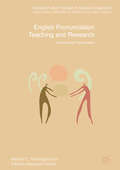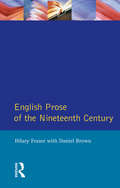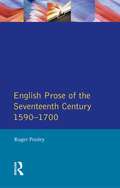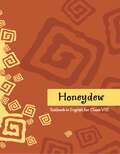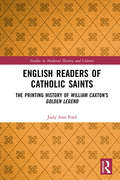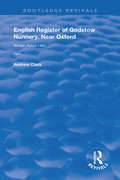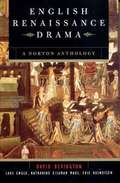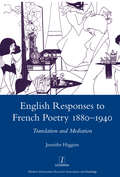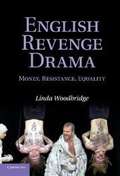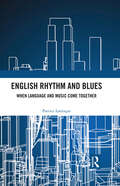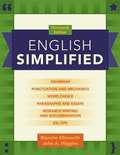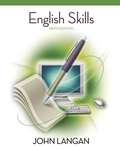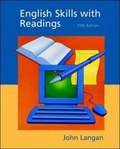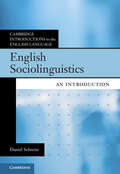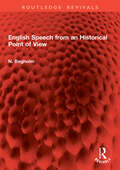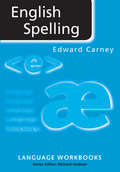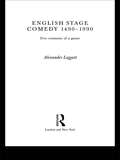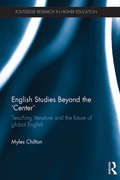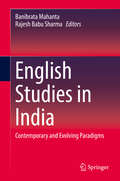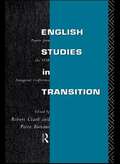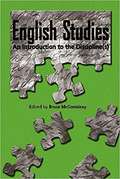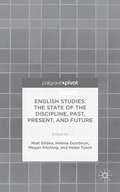- Table View
- List View
English Pronunciation Teaching and Research: Contemporary Perspectives (Research and Practice in Applied Linguistics)
by Martha C. Pennington Pamela Rogerson-RevellThis book offers contemporary perspectives on English pronunciation teaching and research in the context of increasing multilingualism and English as an international language. It reviews current theory and practice in pronunciation pedagogy, language learning, language assessment, and technological developments, and presents an expanded view of pronunciation in communication, education, and employment. Its eight chapters provide a comprehensive and up-to-date analysis of pronunciation and the linguistic and social functions it fulfils. Topics include pronunciation in first and second language acquisition; instructional approaches and factors impacting teachers’ curriculum decisions; methods for assessing pronunciation; the use of technology for pronunciation teaching, learning, and testing; pronunciation issues of teachers who are second-language speakers; and applications of pronunciation research and pedagogy in L1 literacy and speech therapy, forensic linguistics, and health, workplace, and political communication. The chapters also critically examine the research base supporting specific teaching approaches and identify research gaps in need of further investigation. This rigorous work will provide an invaluable resource for teachers and teacher educators; in addition to researchers in the fields of applied linguistics, phonology and communication.
English Prose of the Nineteenth Century (Longman Literature In English Series)
by Daniel Brown Hilary FraserHilary Fraser provides a comprehensive and thorough survey of English prose in the nineteenth century which draws from a wide variety of fields including art, literary theory and criticisim, biography, letters, journals, sermons, and travel reportage. Through these works the cultural, social, literary and political life of the twentieth century - a period of great intellectual activity - can be charted, discussed and assessed.For the first time, an inclusive critical survey of nineteenth-century non-fiction is presented, that traces the century's ideological and cultural upheavals as they are registered in the literary textures of some of its most widely read and influential writings.The book explores the relations between writers who are generally perceived as occupying different discursive spheres, for example between John Stuart Mill, Florence Nightingale and Mrs Beeton; between Cardinal Newman, Elizabeth Gaskell and Hannah Cullwick; and between Charles Darwin, David Livingstone and Henry Mayhew. The establishment and development of different genres and their interactions over the century are clearly mapped. The genre of the periodical essay, a distinctively modern and flexible form catering to the mass readership, is the subject of the introduction, and then more specialist fields are discussed, covering scientific writing, travel and exploration literature, social reportage, biography, autobiography, journals, letters, religious and philosophical prose, political writing and history.
English Prose of the Seventeenth Century 1590-1700 (Longman Literature In English Series)
by Roger PooleyThis is the first book-length history of the range of seventeenth-century English prose writing. Roger Pooley's study begins with narrative, ranging from the fiction of Bunyan and Aphra Behn to the biographical and autobiographical work of Aubrey and Pepys. Further sections consider religious prose from the hugely influential Authorised Version to Donne's sermons, the political writing of figures as diverse as Milton, Hobbes, Locke and Marvell, cornucopian texts and the writings of the new scientists from Bacon to Newton. At a time when the boundaries of the `canon' are being increasingly revised, this is not only a major survey of a series of great works of literature, but also a fascinating social history and a guide to understanding the literature of the period as a whole.
English Reader 11th Standard - Tamilnadu Board
by Training State Council of Educational ResearchEnglish Reader Textbook for the 11th Standard Students, preparing for Tamil Nadu State Board Exam.
English Reader 12th Standard - Tamilnadu Board
by Training State Council of Educational ResearchEnglish Reader Textbook for the 12th Standard Students, preparing for Tamil Nadu State Board Exam.
English Reader Honeydew class 8 - Andhra Pradesh Board
by State Council of Educational Research and Training Andhra PradeshThis book has total Ten chapters. The Best Christmas Present in the world, The Tsunami, Glimpses of the past, Bepin Choudhury's Lapse of Memory, The Summit Within, This is Jody's Fawn, A visit to Cambridge, A short Monsoon Diary, The Great Stone Face 1, The Great Stone Face 2. All the chapters are thematically organized with illustrations and passages meant for listening and reading. Activities focus on before you read, comprehension check, working with the text, Working with language, Speaking and writing.
English Readers of Catholic Saints: The Printing History of William Caxton’s Golden Legend (Studies in Medieval History and Culture)
by Judy Ann FordIn 1484, William Caxton, the first publisher of English-language books, issued The Golden Legend, a translation of the most well-known collection of saints’ lives in Europe. This study analyzes the molding of the Legenda aurea into a book that powerfully attracted the English market. Modifications included not only illustrations and changes in the arrangement of chapters, but also the addition of lives of British saints and translated excerpts from the Bible, showing an appetite for vernacular scripture and stories about England’s past. The publication history of Caxton’s Golden Legend reveals attitudes towards national identity and piety within the context of English print culture during the half century prior to the Henrician Reformation.
English Register of Godstow Nunnery, Near Oxford: Part I (Routledge Revivals)
by Andrew ClarkFirst published in 1905, these two volumes together reproduced the text of Rawlinson MS. B 408 from the Bodleian Library in two parts. They consist of a preface followed the full Middle English text with glosses. The initial section of the manuscript is slightly older and consists of prefixed liturgical pieces such as the Articles of Excommunication. This follows the common historical practice of combining manuscripts to encourage their preservation. The remainder of the text presents the reader with the Register of the Estates of Godstow Abbey. The manuscript was initially created as a translation of the Latin register in order to allow the nuns, who were literate in English but not Latin, to manage their own estates. This manuscript was, at the time of publication, the only known complete English-language cartulary made for a monastic house. It holds significant implications not only for the status, linguistic development and usage of the English language, but also for women’s history in the church and their socioeconomic agency, along with the ability of language to both restrict and open doors. The text includes its own introduction in which the founding of the Abbey by Dame Edyve of Winchester, first Abbess of Godstow, is recounted, followed by deeds relating to the local area.
English Renaissance Drama: A Norton Anthology
by David Bevington Eric Rasmussen Katharine Eisaman Maus Lars EnglePopular in their own time, the 27 plays included here—by Christopher Marlowe, Ben Jonson, John Webster, Thomas Middleton, among many others—reveal why these playwrights' achievements, like Shakespeare's, deserve reading, teaching, and performing afresh in our time. Edited by a team of exceptional scholars and teachers, this anthology opens an extraordinary tradition in drama to new readers and audiences.
English Responses to French Poetry 1880-1940: Translation and Mediation
by Jennifer Higgins"Between 1880 and 1940, English responses to French poetry evolved from marginalised expressions of admiration associated with rebellion against the ""establishment"" to mainstream mutual exchange and appreciation. The translation of poetry underwent a simultaneous evolution, from attempts to produce definitive renderings to definitions of translation as an ongoing, generative process at the centre of literary debate. This study traces the impact of French poetry in England, via a wide range of translations by major poets of the time as well as renderings by now forgotten writers. It explores poetry and translations beyond the limits of the usual canon and identifies key moments of influence, from late 19th-century English homages to Victor Hugo as a liberal icon, to Ezra Pound re-interpreting Charles Baudelaire for the 20th century."
English Revenge Drama: Money, Resistance, Equality
by Linda WoodbridgeVengeance permeates English Renaissance drama - for example, it crops up in all but two of Shakespeare's plays. This book explores why a supposedly forgiving Christian culture should have relished such bloodthirsty, vengeful plays. A clue lies in the plays' passion for fairness, a preoccupation suggesting widespread resentment of systemic unfairness - legal, economic, political, and social. Revengers' precise equivalents - the father of two beheaded sons obliges his enemy to eat her two sons' heads - are vigilante versions of Elizabethan law, where penalties suit the crimes: thieves' hands were cut off, scolds' tongues bridled. The revengers' language of 'paying' hints at the operation of revenge in the service of economic redress. Revenge makes contact with resistance theory, justifying overthrow of tyrants, and some revengers challenge the fundamental inequity of social class. Woodbridge demonstrates how, for all their sensationalism, their macabre comedy and outlandish gore, Renaissance revenge plays do some serious cultural work.
English Rhythm and Blues: Where Language and Music Come Together
by Patrice Paul LarroquePatrice Larroque hypothesizes that early blues singers may have been influenced by the trochaic rhythm of English. English is stressed and timed, which means that there is a regular beat to the language, just like there is a beat in a blues song. This regular beat falls on important words in the sentence and unimportant ones do not get stressed. They are “squeezed” between the salient words to keep the rhythm. The apparent contradiction between the fundamentally trochaic rhythm of spoken English and the syncopated ternary rhythm of blues may be resolved as the stressed syllables of the trochee (a stressed-unstressed sequence) is naturally lengthened and assumes the role of one strongly and one weakly stressed syllable in a ternary rhythm. The book suggests investigating the rhythm of English and the rhythm of blues in order to show how the linguistic rhythm of a culture can be reflected in the rhythm of its music.
English Second Language class 10 - GSTB: અંગ્રેજી દ્વિતીય ભાષા ધોરણ ૧૦
by Navneetગુજરાત માધ્યમના વિદ્યાર્થીઓ માટે ગુજરાત રાજ્ય માધ્યમિક અને ઉચ્ચતર માધ્યમિક શિક્ષણ બોર્ડ (GSEB) દ્વારા માન્યતા પ્રાપ્ત અંગ્રેજી (બીજી ભાષા) ધોરણ 10 ની વિશેષ પુસ્તક છે, જેનું આયોજન નવનીત એજ્યુકેશન લિમિટેડ દ્વારા થયું છે. આ પુસ્તક ગુજરાતી ભાષાના માધ્યમથી ગણિત વિષયમાં વધુ સારી રીતે સમજવામાં આવે છે. આ પુસ્તક માં "પ્રસ્તાવના", "ક્રમિકતા અને સુસંગતતા", "શબ્દભંડોળ", "વાક્યરચના", "વાચન કૌશલ્ય", "લેખન કૌશલ્ય" અને "ભાષાની સમજ" વગેરે વિભાગો છે, જે ગુજરાતી ભાષાને સરળ અને સ્પષ્ટ રીતે શીખવાનું માટે બનાવામાં આવ્યું છે. આ પુસ્તકની વિવિધ વિભાગો વિચારે વિદ્યાર્થીઓ માટે ગુજરાતી ભાષાને સમજવાનો તરીકો અને તેનું ઉપયોગ શીખવાનું ઉદ્દેશ્ય છે. પ્રત્યેક વિભાગ માં ગુજરાતી ભાષાના વિવિધ મુદ્દાઓને સ્પષ્ટતા અને સરળતાથી સમજાવે છે. આ પુસ્તકમાં આપેલા વિવિધ વિભાગો માં ગુજરાતી ભાષાનું મહત્ત્વ, તેની શીખવાની રીત, શબ્દાવલીનો વિસ્તાર, વાક્ય રચના, વાચન અને લેખન કૌશલ્ય, અને ભાષાની સમજ વગેરે મુદ્દાઓ શામેલ છે. એવી આ પુસ્તક વિદ્યાર્થીઓને ગુજરાતી ભાષા માં સરળતાથી સમજવા અને બીજી ભાષા તરીકે ઉપયોગ કરવાનું માર્ગદર્શન આપે છે.
English Simplified
by Blanche Ellsworth John A. HigginsAt only 80 pages, English Simplified is a concise, inexpensive grammar handbook that has long been the choice of instructors due to its reliability.
English Skills (9th edition)
by John LanganThe ninth edition of English Skills features John Langan's trademark crystal-clear explanations, along with his range of motivating activities and writing assignments that reinforce the four bases of effective writing: unity, support, coherence, and sentence skills.
English Skills with Readings (Fifth Edition)
by John LanganEnglish Skills with Readings will help students learn and apply the basic principles of effective composition. It will also help them master essential reading skills. It is a nuts-and-bolts book based on a number of assumptions or beliefs about the writing process.
English Sociolinguistics: An Introduction (Cambridge Introductions to the English Language)
by Daniel SchreierCovering both traditional topics and innovative approaches, this textbook constitutes a comprehensive introduction to English sociolinguistics. Reflecting the field's breadth and diversity, it guides students through the development of research on language and society over the last sixty years, as well as global trends and related fields such as World Englishes, language politics, language and inequality, and translanguaging. It features practical activities, for both individual work and in-class discussion, as well as vignettes introducing specific case studies, additional information on 'out of the box' topics, key terms, and examples from around the world and various social settings. Inspiring, personal and authoritative interviews with leading sociolinguists conclude the book. Assuming only a basic understanding of the English sound system and its grammar, and supported online by additional activities and selected model answers, this is the ideal text for undergraduates wanting an accessible and modern introduction to the field.
English Speech from an Historical Point of View (Routledge Revivals)
by N. BøgholmFirst published in 1939, English Speech from an Historical Point of View presents the history of the English language under three major components: Old English, Middle English and Modern English. Each of these divisions, with the partial exception of Modern English, treats English with regard to phonology, morphology and syntax.The author argues that it has not always been found practical to stick exclusively to the 3 periods in dealing with some phenomenon which may have had its full development within one particular period, while it had its origin or faded away in another. Particular regard has been had to Shakespearean English. Otherwise, a selection has been made of Middle English (and Old English) texts which are most representative. This is an important historical work for students of English language.
English Spelling (Language Workbooks)
by Edward CarneyEnglish Spelling explores the rules and conventions on which present-day English spelling is based.This Language Workbook:* Examines how speech-sounds map onto each other* Explores the extent to which words sound identical or look identical* Analyzes various kinds of spelling mistakes* Looks at the main differences between American and British spelling* Shows how and why the names of people and places may vary from expected spelling conventions* Deals with the punctuation of words by apostrophes, hyphens and capitalisation* Considers several possible approaches to spelling reform
English Stage Comedy 1490-1990: Five Centuries Of A Genre
by Alexander LeggattFirst published in 2004. Routledge is an imprint of Taylor & Francis, an informa company.
English Studies Beyond the 'Center': Teaching literature and the future of global English (Routledge Research in Higher Education)
by Myles ChiltonThis book addresses the shape of English studies beyond the ‘center’ by analyzing how the discipline has developed, and by considering how lessons from this analysis relate to the discipline as a whole. The book aims to open a cross-disciplinary conversation about the nature of the English major in both non-Anglophone and Anglophone countries by addressing the tensions between language and literature pedagogy, the relevance of a focus on hyper-canonical Anglophone literature in a world of global Englishes, world literature, and multilingual students, and by reflecting on the necessary contingency and cross-purposes of blended literature and language classrooms. Many of the book’s points of discussion arise from the author’s experience as an English professor in Japan, where the particularities of English language and literature pedagogy raise significant challenges to Anglo-centric critical and pedagogical assumptions. English Studies Beyond the ‘Center’: Teaching Literature and the Future of Global English therefore argues that English literature must make a case for itself by understanding its place in a newly configured discipline. Issues discussed in the book include: English language and literature pedagogy in Japan The modes through which EFL and English literary studies converge and diverge Globalized English beyond the Anglo-American perspective English classroom practices, particularly in Japan
English Studies in India: Contemporary And Evolving Paradigms
by Banibrata Mahanta Rajesh Babu SharmaThis volume is a collection of scholarly papers that explore the complex issues concerning English Studies in the present Indian context. The discussions in this volume range from historical perspectives to classroom-specific pedagogies, from sociological and political hierarchies to the dynamics of intellectual development in the English language environment. Interrogating both policy and practice pertaining to English Studies in the context of Indian society, culture, history, literature and governance, the chapters seek to formulate contemporary perspectives to these debates and envision alternative possibilities. Since the introduction of English to India more than 2 centuries ago, the language has transmuted the very fabric of Indian society, culture, history, literature and governance. The idea of India cannot be conceived in its entirety without taking into consideration the epistemological role that English has played in its formation. The present globalized world order has added dimensions to English Studies which are radically different from those of India’s colonial and postcolonial past. It is therefore imperative that the multitudinous shades and shadows of the discipline be re-examined with inputs drawn from the present context. This volume is for scholars and researchers of English literature and language studies, linguistics, and culture studies, and others interested in exploring new paradigms of engagement with the disciplinary formulation of English Studies in India.
English Studies in Transition: Papers from the Inaugural Conference of the European Society for the Study of English
by Robert Clark Piero BoitaniBringing together twenty-five contributors from all over Europe, this volume represents the vitality and diversity of the current transcultural European dialogue on English studies. Topics addressed include: * the nature of the canon * the poetics of language * the representation of women and the notion of nationalism in post-colonial literature. The significance of this volume lies not only in the quality of the individual contributions but also in the fact that it marks an important turning point in the history of English studies in Europe.
English Studies: An Introduction to the Discipline(s) (Refiguring English Studies)
by Bruce McComiskeyWell-known scholars in the field explore the important qualities and functions of English studies' constituent disciplines--Ellen Barton on linguistics and discourse analysis, Janice Lauer on rhetoric and composition, Katharine Haake on creative writing, Richard Taylor on literature and literary criticism, Amy Elias on critical theory and cultural studies, and Robert Yagelski on English education--and the productive differences and similarities among them that define English studies' continuing importance. <P><P> Faculty and students in both undergraduate and graduate courses will find the volume an invaluable overview of an increasingly fragmented field, as will department administrators who are responsible for evaluating the contributions of diverse faculty members but whose academic training may be specific to one discipline. <P><P> Each chapter of English Studies is an argument for the value--the right to equal status--of each individual discipline among all English studies disciplines, yet the book is also an argument for disciplinary integration.
English Studies: The State of the Discipline, Past, Present, and Future
by Niall Gildea Helena Goodwyn Megan Kitching Helen TysonAn accessible and wide-ranging consideration of concerns facing English Studies in its surrounding context of the university and society. The contributors to this volume seek to trace, in the face of current challenges, historical and contemporary debates surrounding English Studies.
